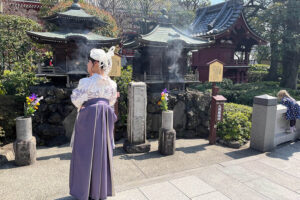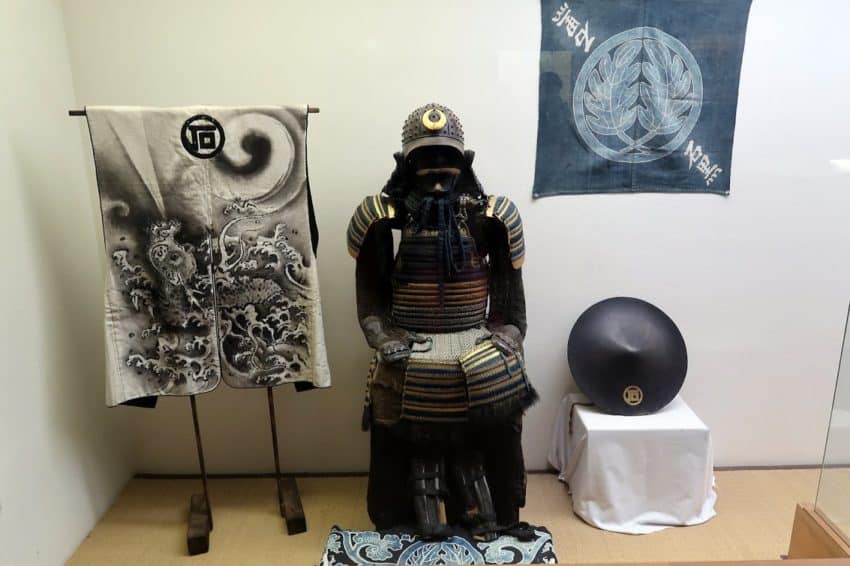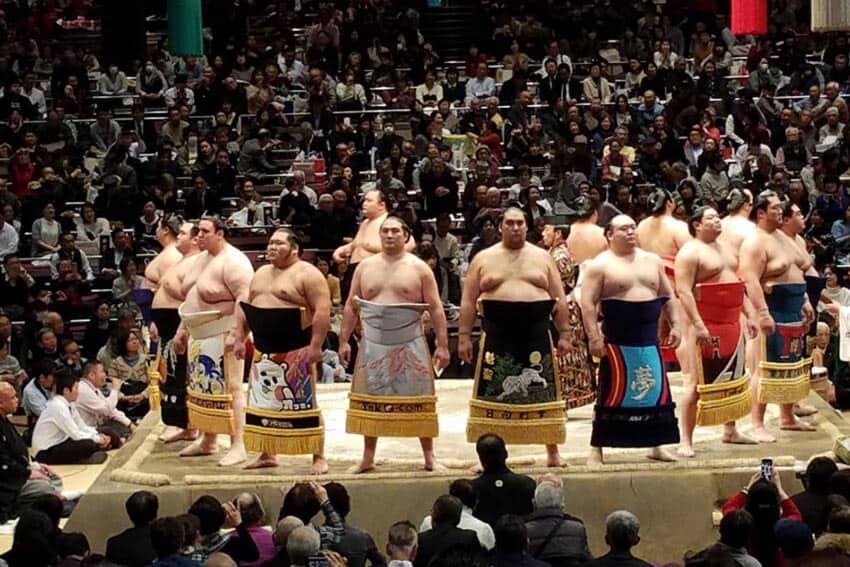By Dennis W. Lid

They are one of a kind, considered to be sacrosanct safe havens and held dear to our hearts. Places we consider unique and special are found on rare occasions as we travel through life. Something about those locations causes them to become firmly embedded in our psyche.
Our experience there leaves a permanent and profound impression on us that remains with us for the rest of our lives. The Holy Family Mission at Saku is one such place – a safe refuge, a peaceful sanctuary and a holy retreat.
Saku is a rural town about four hours distant by car or motorcycle to the northwest of Tokyo, Japan, on the main Island of Honshu. It is located in a river valley amidst the hill country at the foot of the Japanese Alps. We found it and the mission on a motorcycle trip.
High in the Alps
It was early on a sunny Sunday morning, as the Camp Zama Motorcycle Club was returning from a destination high in the Japanese Alps, that we first encountered the Holy Family Franciscan Mission at Saku. A few of our Catholic brethren were looking for a church so that they could attend Mass.
The ZMC riders pulled into a department store plaza that provided off-road parking. A few of our entourage were proficient in the Japanese language and queried some of the local bystanders about the location of a church.
They hit “pay dirt” with one woman shopper exiting the store. She even spoke a few words of English, an unusual occurrence in the rural areas of Japan.
As she hopped into her Honda mini-truck, she motioned the ZMC riders to follow her. We left the parking plaza, followed the woman in the truck down an alley adjacent to the department store, and made an acute left turn up a narrow road one block behind the store where we arrived at the Holy Family Mission.
The lady in the truck pointed at the church and waved goodbye as she motored up the road. The ZMC riders drove into the circular turnaround area, or driveway, in front of the mission and parked their motorcycles. They had arrived. Now what? While the Catholic members went to Mass, the others looked around the interesting mission grounds.

A statue of Saint Francis of Assisi was in the center of the circular entryway surrounded by a beautiful rose garden about 40 feet in circumference enclosed by the driveway.
On the other side of the circular drive, facing the narrow road was the small mission chapel where Catholic Mass was in progress. The area around the church was like a fairytale land for kids. In fact, there was a child daycare center and school on those grounds.
Unique Handmade Items
Surrounding both chapel and school were an array of unique, even bizarre, handmade items and devices for both decoration, and as rides and playthings for small children.
Around the periphery of the circular rose garden was an overhead, moving cable with shiny, aluminum, pie-plate mobiles hanging therefrom, spinning in the breeze and shimmering in the sun.

The cable was propelled by a pulley system attached to a paddle wheel turned by the flowing waters of a shallow stream that ran through the length of the mission property.
Some of the water was diverted from the stream to water the garden and provide a streamlet as the source of energy to operate this device. It was a fascination to all the children and guests of the mission.
Exciting Anomalies
There were other exciting anomalies on the mission grounds as well. The daycare and school children eagerly awaited their turn at trying them all. There was a large television cabinet on a raised platform allowing the kids access to the rear of the TV screen where they “hammed it up” as if they were performing actors in a drama – and how they loved to “ham it up.”
Then, again, there was a rowboat in the shallow stream with a rope and pulley system allowing the children to pull the boat, and themselves within it, upstream 20 feet or so and permitting them to float back downstream and bump into the pier, then start the process all over again.
The boat device was built in such a way so as to prevent any danger in the first place, but an adult was always in attendance to ensure the children’s safety.
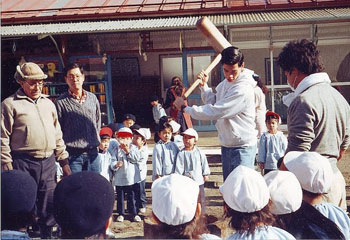
Making Mochi
Another interesting feature farther upstream was a “mochi” (glutinous rice delicacy) making station. Making “mochi” is a long-standing Japanese New Year’s tradition. The device consisted of a small, rustic cottage containing a very large wooden bowl holding the “mochi,” and wooden “mochi” pounding mallets operated by two human mannequins dressed in traditional Japanese New Year ceremonial garments.
The mannequins’ movements in pounding the “mochi” were stream and paddle wheel actuated. It was an ingenious invention that absolutely captivated its audience of children and adult observers.
Other sights captured one’s eye and imagination while walking through the mission grounds. There were the usual children’s playthings such as sliding boards, teeter-totters, and swings. These were not unique, but their arrangement and positioning amongst the other mechanical innovations made them seem so. Regardless, the children enjoyed them immensely.

In between their physical exertions, the kids eagerly observed the fenced-in ‘Evangelists’: Mathew, Mark, Luke and John –- four large turkeys so named by the mission priest, Father Gabriel Alba.
The “fowl four” roamed freely within their fenced confines on the mission grounds. The turkeys would repeatedly gobble and the children would joyfully return their turkey calls. It was a conversation to which only they were privy.
The centerpiece of the mission grounds was the Catholic Chapel. It was built over the years by Father Gabriel Alba, a Colombian, Franciscan, missionary priest whom we called Padre and by his Japanese handyman. It was one-of-a-kind, indeed.
The church structure was made of natural, rustic wood throughout on a cement foundation. Everything within it was hand hewn from pews through other furnishings and accessories to the altar itself, which was of a large, one-piece, finely shaped, carved and smoothly finished, hardwood tree trunk.

The chandeliers hanging from the vaulted ceiling were welded wrought-iron light fixtures incorporating fish designs. These were also constructed by the Padre and his colleague.
Behind the altar was an immense plate glass window from ceiling to floor. Outside the window was a huge wooden cross centered on a man-made, rock grotto and water pool with a cascading, pump-operated waterfall in the background.
The waterfall was activated during Sunday Mass and had a soothing effect on the small congregation, as did the Gregorian chant music emanating from a tape recorder and audio system within the chapel.
As Padre Gabriel said Mass, there was a palpable aura of spirituality and holiness present in the small mission church, made so by his humble and devout rendering thereof.

After Mass, the Padre invited all the motorcyclists into the mission hall for coffee and sweet rolls. His cook and assistant helped in the preparation and serving of the repast. The bikers were pleasantly surprised by this generous, ecumenical gesture of brotherly love, and they determined to return the favor.
Thanksgiving at the Holy Family Mission
They discussed how they might do so as they enjoyed their coffee and snack. Their spokesman made a proposal of providing all ingredients and preparing the Thanksgiving Day meal for Father Gabriel and his small staff since that American Holiday was up-and-coming in a month and would be an ideal occasion for a club motorcycle trip as well.
The Padre was agreeable to this reciprocal goodwill gesture and offered his kitchen, staff and mission hall for use at this event. That agreement constituted the beginning of a ZMC legacy – the Thanksgiving Day meal tradition at the Saku Holy Family Mission.

The tradition was firmly established the following month on that first Thanksgiving Day event at the Holy Family Mission. Several members of the ZMC arrived at the mission by motorcycle and van with the makings of a complete Thanksgiving Day meal.
With the Padre’s permission, they commandeered the kitchen and utensils to cook the meal, assisted the small mission staff in preparing the dining area in the mission hall, and arranged all the table settings, accessories and condiments for the banquet.
Then the turkey meal was served after an appropriate toast to the good health of Padre and his staff.
The event was a rousing success and established itself as an annual tradition between the mission and the ZMC. It has been an ongoing tradition for years. This was the legacy established by the ZMC.
Even after the demise of the club, the Thanksgiving Day meal tradition continued with non-motorcyclist members of the Camp Zama military community so strong was the established legacy. It was a unifying and communal event and a melting pot of camaraderie that established a true bond of brotherly love.
Once having experienced this legacy, how could one ever forget Saku and the love of neighbor practiced there? The Holy Family Mission at Saku is, without a doubt, a one-of-a-kind safe refuge, peaceful sanctuary, and a holy retreat dear to our hearts.
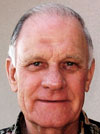
Dennis W. Lid served in the U.S. Army Infantry, Airborne and Special Forces worldwide during peace and war for over 20 years. Major Lid retired in 1980. Freelance writing, reading and motorcycling through parts of Asia, Europe and the USA have been the favorite passions of his life. He is previously published in several online and offline publications around the world. Visit his website Lid’s Lair to review the titles of his published works, including excerpts from his book entitled First to Last – The Tale of a Biker.
- Mongolia, the Land of Eternal Blue Sky - April 20, 2024
- These 9 U.S. National Parks Require Reservations in 2024 - April 17, 2024
- Take a Hike in Olympic National Park - April 17, 2024



